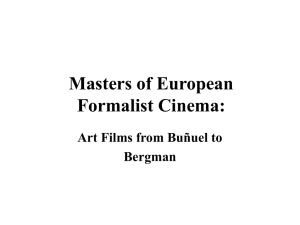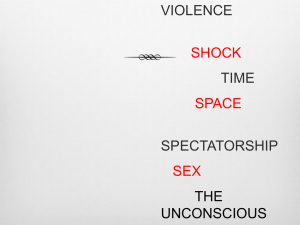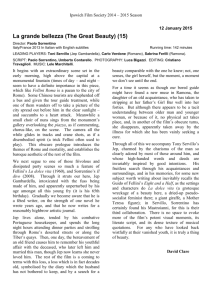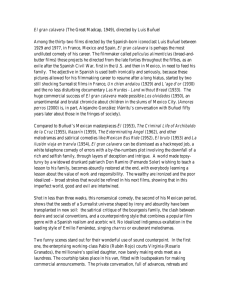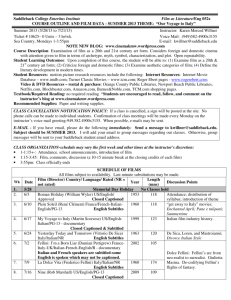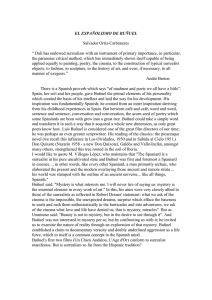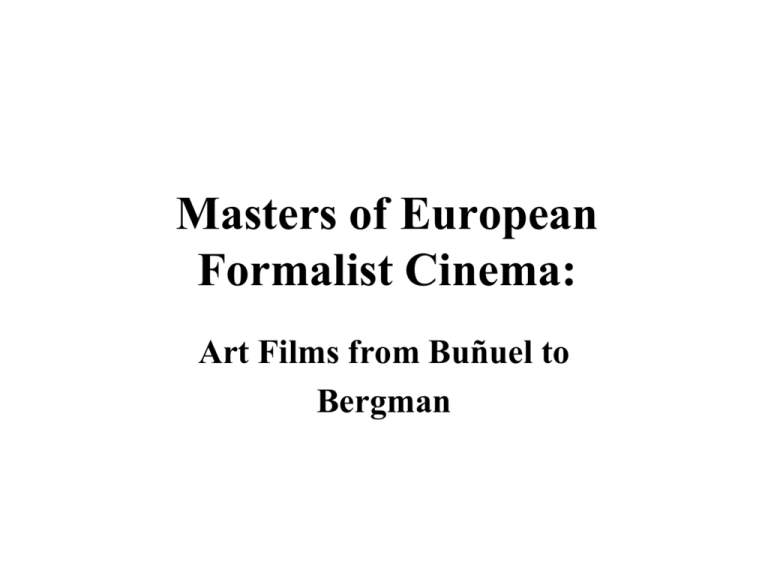
Masters of European
Formalist Cinema:
Art Films from Buñuel to
Bergman
・Luis Buñuel (1900-1983
Spanish/Mexican)
・Robert Bresson (1901-1999 France)
・Jacques Tati (1908-1982 France)
・Ingmar Bergman (1918-2007 Sweden)
・Federico Fellini (1920-1993 Italy)
European Art Cinema
• European film less commercial and more
personal reflecting personal concerns to the
almost obsessive level.
• Being personal (less commercial) means more
unconventional filmmaking.
• European film as art film. Bold formal
experiment and artistic formal attempt.
• Innovations in narrative and visual styles.
• Distinguished personal styles.
• Auteurs
Luis Buñuel
• Luis Buñuel - friend of
Salvatore Dali and
Federico Garcia Lorca
• Founded film club in
Madrid and wrote film
reviews
• Entered film producing
circles in Paris and made
his first film Un Chien
Andalou in 1928
• Film of instinct, Freudian
and Surrealistic
Luis Buñuel
• L’Âge d’or (The Golden Age, 1930) radically antibourgeois and anti-clerical film backed by Freudian
psychoanalytic theory. The cross-cutting of the
scenes in which bourgeois audiences are attending a
concert and a couple making love. Freudian
revelation of bourgeois hypocrisy. Concert
Luis Buñuel’s
Surrealism
• Left Spain after fighting in the Spanish Civil War.
Found difficult to get work in US, he settled in
Mexico. Returning to Europe after the war, he
made a series of films attacking the hypocrisy of
the bourgeoisie and the church.
• The Discreet Charm of Bourgeoisie (1972)
Luis Buñuel’s
Surrealism
• Written by Luis Buñuel and Jean-Claude Carrière,
and directed by Buñuel, the film is a satire about a
group of bourgeois friends trying to have dinners
together.
• Surrealistic images; Surrealistic incidents (episodes)
• Story within story; dream within dream
Luis Buñuel’s
Surrealism
• Dream (surrealistic) elements - satire of bourgeois
manners, concerns, pretensions, preoccupations and
hypocrisy.
• One lunch is postponed as the host and hostess have
a sex outdoors - not because they cannot control
their urge but because by suppressing it they admit
they have it.
Luis Buñuel’s
Surrealism
• In one failed dinner party, the group of middle
class diners are seen on stage but one of them,
Henri, is unable to memorize his lines.
• (Freudian psychoanalytic) Fear of humiliation in
front of the public.
Luis Buñuel’s
Surrealism
• In one dream, the South American ambassador of
a fictional country shoots his host for insulting his
country. He does so, not because the insult is
untrue, but you do not say such things in public.
• Bourgeois pretension and keeping-up appearances
• Absurdity of pride, public manners, and etiquette
Magic of Ingmar Bergman
• Bergman’s films are noted for
the bleak depiction of human
vulnerability, loneliness and
torment.
• Several stages of Bergman’s
directorial career.
• Psychological tension,
religious anguish, sexual guilt,
and other spiritual torment are
presented through oneiric and
magical images.
Ingmar Bergman
• Wild Strawberries (1957) - meditation of old age
and the regret and guilt of adolescence
Ingmar Bergman
• Through a Glass Darkly (1961) is about the lack
or loss of religious faith. (Corinthians 13.12)
• Theatrical - Chamber film inspired by chamber
plays of August Stringberg with a small cast and
in a small place. Departure
Ingmar Bergman
• The film takes place in a single 24-hour period,
features only four characters and takes place
entirely on an island.
• Little dramatic action and mainly words.
• Shot in low-key lighting and in long take.
Ingmar Bergman
• Winter Light (1963) and Silence
• Both deal with the boundary between sanity and
madness, and human contact and estrangement.
Ingmar Bergman
• The Winter Light follows the existential crisis of
Thomas Ericsson, pastor of a small Swedish
church. The crisis involves in a love affair and
losing his faith.
• Six minutes long take shows Märta speaking to
the camera the contents of the letter that she read.
Ingmar Bergman
• Silence is about two sisters – the sensuous
younger sister and intellectual elder sister - and
their tense relationship. Whether they are liberal
or repressive, they are deeply lonely and
estranged almost at the point of losing sanity.
Ingmar Bergman
• Study of narcissistic but confused and alienated
characters Persona (1966)
Federico Fellini
• Fellini - the most original
film director with the most
distinctive film style.
• Helped inaugurate
Neorealismo as a
screenwriter but developed
his own distinctive cinema
style a director.
Dreams in Federico Fellini
Recurring motifs and themes
• Circus, festivals, music halls, parades, marches
• Clowns, angelic figures, holy fools
Dreams in Federico Fellini
• Whores, nurturing mother figures, large women
Dreams in Federico Fellini
• Childhood and young adulthood memories
and recollections
Dreams in Federico Fellini
• Mesmerizing images since his childhood
Dreams in Federico Fellini
• Empty seashores, desolate roads, deserted
town squares at night
Dreams in Federico Fellini
• Characters at their most bizarre
Dreams in Federico Fellini
• Hallucinatory or dreamlike imagery
• Jungian realization that ‘extra-sensory’
perceptions are the psychic manifestation of the
unconscious
• Oneiric
8 1/2 (1963)
Images and Imagination of Fellini
• Dolce Vita (1960) a work which marks the
beginning of Fellini’s later film style. A
journalist’s search for love and happiness in a
new period of sexual liberation.
• Strong images derive from free imagination
Images and Imagination of Fellini
• Bold compositions created by low-key lighting
• Expressively erotic images which were not
allowed in conventional film making.
• Physical and sensuous: appeals to libidul
sensitivity of the audience

